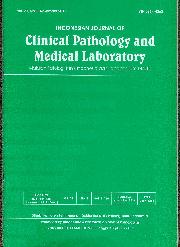Indonesian Journal of Clinical Pathology and Medical Laboratory
ISSN 0854-4263
Vol. 21 / No. 1 / Published : 2014-01
Order : 14, and page :67 - 74
Related with : Scholar Yahoo! Bing
Original Article :
Hpv genotype and hpv infection pattern related to the histopathological type of cervical cancer)
Author :
- Roudhotul Ismaillya Noor*1
- Aryati*2
- Pudjo Hartono*3
- Departemen Patologi Klinik FK UNAIR/RSUD Dr. Soetomo Surabaya,
- Dosen Fakultas Kedokteran
- Departemen Obstetri dan Ginekologi FK UNAIR/RSUD Dr. Soetomo Surabaya
Abstract :
Uterine cervical cancer is the number one cause of female cancer in Indonesia. The most common cause is a persistent infection with ahigh risk of HPV (Human Papilloma Virus). A multiple genotype HPV infection with high risk HPV increases the poor prognosis of cervicalcancer. Non-squamous type of cervical cancer has a poorer prognosis than the squamous type. The aim of this study was to know theassociation between HPV genotype and HPV infection pattern with histopathological type of cervical cancer in patients of the Dr. SoetomoHospital, Surabaya. This study was an analytical observational-cross sectional research. The samples consisted of 44 uterine cervicalswabs from the Oncology Out-Patient Clinic, proven and diagnosed as the related cervical cancer in October-November 2012. PCR resultsshowed 33 HPV positive, seven (7) HPV negative and 4 invalid. The Fisher’s exact test was only done for the 33 positive HPV samples.The positive HPV samples consisted of 24 squamouse and nine (9) non-squamous types of uterine cervical cancer. A 90.9% (30/33) highrisk HPV genotypes was found in 72.7% (24/30) squamous and 18.2% (6/30) non-squamous types. Multiple genotype HPV infection9.1% (3/33) occurred in 3% (1/3) squamous and 6.1% (2/3) non-squamous types. There was a significant association between HPVgenotype and histopathological type of the uterine cervical cancer (p=0.015). There was no association between HPV infection patternand histopathological type of uterine cervical cancer (p=0.174). Negative HPV and low risk HPV genotypes can be found in uterine cervicalcancer patients of the Dr. Soetomo Hospital, Surabaya. Multiple genotype HPV infections have a 2.86 times greater risk in developingnonsquamous type with a poor prognosis. Kanker leher rahim merupakan urutan pertama keganasan di perempuan Indonesia. Penyebab kanker leher rahim terseringadalah infeksi Human Papilloma Virus (HPV) berkebahayaan tinggi yang menetap. Infeksi multiple genotype HPV ditingkatkan olehgenotipe HPV berkebahayaan tinggi dan merupakan perjalanan penyakit kanker leher rahim yang buruk. Jenis nonkanker leherrahim skuamosa memiliki perjalanan penyakit lebih buruk daripada jenis skuamosa. Penelitian ini bertujuan untuk mengetahuigabungan antara genotipe HPV dan pola infeksinya serta jenis histopatologis kanker leher rahim pasien yang didapat di RSUD Dr.Soetomo, Surabaya. Penelitian bersifat pengamatan analisis, potong lintang. Sampel terdiri dari 44 sapuan leher rahim (uterinecervical swab) pasien yang terdiagnosis pasti mengidap kanker leher rahim di Poli Onkologi pada bulan Oktober-November 2012.Hasil PCR adalah 33 HPV positif, tujuh (7) HPV negatif dan empat (4) tidak memenuhi persyaratan. Uji kepastian Fisher hanyadilakukan terhadap 33 sampel HPV positif. Sampel HPV positif terdiri dari 24 pengidap kanker leher rahim jenis skuamosa dansembilan (9) yang nonskuamosa. Genotipe HPV berkebahayaan tinggi 90,9% (30/33) ditemukan di 72,7% (24/30) pasien kankerleher rahim jenis skuamosa dan 18,2% (6/30) yang nonskuamosa. Infeksi multiple genotype HPV 9,1% (3/33) terjadi di 3% (1/3)jenis skuamosa dan 6,1% (2/3) nonskuamosa. Ada hubungan bermakna antara genotipe HPV dan yang terkait histopatologis kankerleher rahim (p=0,015). Antara pola infeksi HPV dan jenis histopatologi kanker leher rahim (p=0,174) tidak ada hubungan yangbermakna. HPV negatif dan yang berkebahayaan rendah dapat dijumpai di pasien kanker leher rahim yang dirawat/memeriksakandiri di RSUD Dr. Soetomo, Surabaya. Infeksi multiple genotype HPV memiliki kebahayaan 2,86
Keyword :
HPV genotype, HPV infection pattern, histopathological type of cervical cancer,
References :
Hariri S, Dunne E, Saraiya M, Unger E, Markowitz L,(2011) Chapter 5: Human Pappillomavirus. VPD Surveillance Manual Hal : 5–1. : 5th Ed., Human Papillomavirus
Lyon, France,(2006) International Agency for Research on Cancer Vol 98 Hal 303-15 : Natl Cancer Inst
Archive Article
| Cover Media | Content |
|---|---|
 Volume : 21 / No. : 1 / Pub. : 2014-01 |
|













